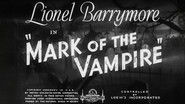Cineanalyst
Spoilers Warning Elaborated: I'm going to discuss the endings of "The Cat and the Canary," "London After Midnight" (both 1927) and "Dracula" (1931), as well as that of this film, "Mark of the Vampire." The same director, Tod Browning, and star, Bela Lugosi, of "Mark of the Vampire," made the landmark 1931 horror film "Dracula." That production essentially invented horror as a Hollywood genre, and it created the iconic portrayal of a cornerstone character of horror with Lugosi's thick Hungarian accent, posturing and theatrical gestures. Since reading Bram Stoker's novel, I've been watching a bunch of Dracula movies, and it's abundantly clear that the 1931 film and particularly Lugosi's performance has had a pervasive influence on subsequent vampire pictures (as well as culture in general). With the same director and actor having another go at similar material, "Mark of the Vampire" is one of the more obvious examples of this.Partially, "Mark of the Vampire" is Browning's third attempt at adapting Stoker's book, after "London After Midnight" and "Dracula," and it's an unacknowledged remake of the former, now-lost silent film. Although we can't judge the 1927 lost film anymore beyond reconstructions based on stills, such as the 2002 one for Turner Classic Movies by Rick Schmidlin, "Mark of the Vampire" can be appreciated for improving on parts of the same director's "Dracula." Being an unauthorized and partial adaptation (which, reportedly, Universal (producer of the 1931 film) considered suing MGM (the producer of this film) over, anyways), it lacks the best parts of "Dracula," including the Transylvania scenes. Most of its narrative takes place in what were the stagiest scenes of the 1931 film-those in Seward's home and sanitarium-here, the estate of Baron Otto. Likewise, Count Mora's lair stands in for Dracula's Carfax Abbey. "Bat thorn," too, replaces Universal's "wolf's bane," which replaced Stoker's garlic, to begin with, as the natural protection from vampirism. While nothing exceptional otherwise, these scenes in "Mark of the Vampire" feature superior blocking and scene dissection, including plentiful reaction shots, compared to "Dracula." Due surely to improvements in synchronized-sound technology in the four years between the films, characters seem to be afforded freer movement within the spaces. Not even Karl Freund's mobile camera could mask the cramped limitations of the sound stages in "Dracula." There's also howling sound effects in "Mark of the Vampire" and a better use of off-screen dialogue as a transition between shots.The third and best major set within "Mark of the Vampire," the foggy, miskept graveyard, is unlike anything in the 1931 film. It affords Browning to develop Stoker's undead Lucy character-here, renamed "Luna." Her slow, deliberate walking and mute posturing remains haunting despite reminding one of today's goth youth subculture. Another nice Stoker-esque touch is the opening scene of gypsies-who, in the novel, helped Dracula move out and back to his Transylvanian castle. The opening wipe transition from a church tower is awkward, though.The insert shots of animals are better here, too, perhaps because Browning seems to have just went all-out with them, including bats, beetles, opossums, an owl, a brief shot of what appears to be a wolf in the background of one graveyard scene, rats, a fake spider climbing up the wall, and a strange crab-like-spider prop crawling on the floor in another shot. The obviously-fake flying bats are cheesy, but the bat theme, overall, is further assimilated into the narrative, including a shot where Luna swoops down in partial-bat form. In another scene, there's a substitution splice to show the transformation of Count Mora from bat to humanoid vampire.The cast is good, including enjoyable performances from character actors Lionel Atwill (as an inspector akin to his in "Son of Frankenstein" (1939)), Leila Bennett, Donald Meek and Ivan Simpson. Jean Hersholt, who has a humanitarian award named after him in real life, is well cast as the villain; his real-life image makes his villainy here doubly surprising. Carroll Borland and Lugosi, as always, are fantastic vampires despite their lack of dialogue. In the leading role, Lionel Barrymore is one of the more interesting to watch Van Helsing types. He's an expressive actor, and he draws attention just by the way he leans towards those he's talking to or with his constant fidgeting with his glasses.Many dislike the ending of "Mark of the Vampire." I think it's the best part. Before "Dracula" defined the genre, some proto-horror films would explain away the supernatural within the framework of a murder mystery. "The Cat and the Canary" (1927) did this, so did "London After Midnight." Although it's largely illogical (Why would the murderer believe his victim turned vampire? How exactly did he extract the blood again? What did he do with it? How is this confession expected to hold up in court? Etc.) and makes the film's preceding scenario into an absurdly-elaborate hoax, I like how it's self-referential. The movie itself and movies in general, after all, are an elaborate hoax. Moreover, like Browning once again tackling Stoker's novel, the hypnosis-aided confession is a reenactment-adding new twists to a familiar scene.I think Browning and company were being intentionally self- referential with this, too, especially by playing on the persona of its star vampire. In "London After Midnight," Lon Chaney played dual roles as the Dracula and Van Helsing types; one in heavy makeup, the other not. The reveal that he was an actor reflected Chaney's star image as "the man of a thousand faces." For this remake, Lugosi only plays the Dracula role-the part he had and continued to play on the stage, the one that made him a cultural icon in the 1931 film and the role that haunted him for the rest of his life and after-even being buried in the Count's costume. In "Mark of the Vampire," when he's revealed to be an actor in the final scene, he states, "I gave all of me. I was greater than any real vampire." He's right.










